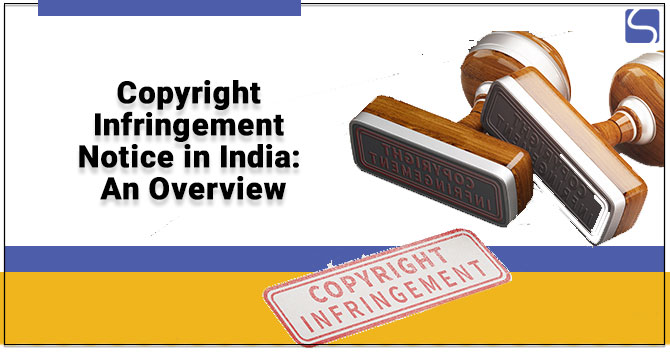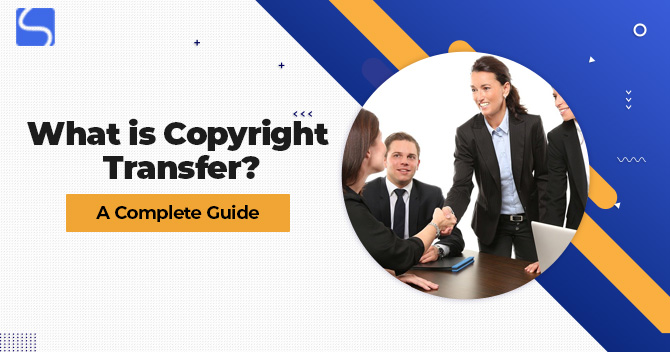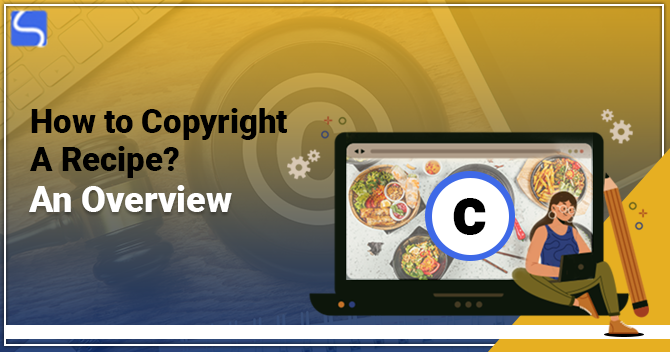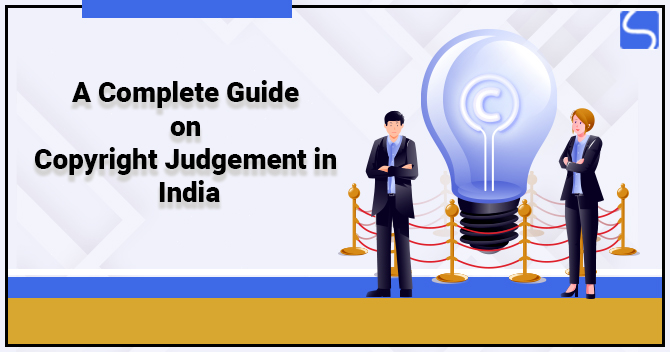Copyright Infringement Notice in India: An Overview

Karan Singh | Updated: Jun 09, 2021 | Category: Copyright
Intellectual Property Rights is a right over the creative work which comprises human intelligence or creativeness. Just like other Intellectual Property, a Copyright grants the actual inventor or author ownership over their work invented or created by them. Copyright is a bunch of rights due to the quality of safeguarding a diverse set of fictional & creative works. Section 13 in the Copyright Act, 1957, delivers for the provisions that an individual can claim Copyright over actual artistic work, literary, dramatic, sound recording, musical, and cinematograph films. If any creator or author, after claiming a Copyright on their work, finds any authorised use of Copyright by a third party, they can file a Copyright Infringement Notice. In this blog, we will understand how to file a Copyright Infringement Notice in India.
Table of Contents
An Overview of Copyright Infringement
It is merely put to safeguard the use of the actual work of an inventor or a creator by a third party. Under the Copyright Act, 1957[1], the exclusive right to safeguard artistic & literary works is given to the Copyright owner alone. According to the provisions of Section 18 of the Act, the Copyright owner could be a Copyright assignee or the work creator. An individual requires permission from the actual owner of the Copyright in the form of a license to makes use of their work which is safeguarded under the Copyright Act, 1957. For instance, the actual owner of a book reserves a right for the distribution of their work. But, if the store of the books fails to obtain a license from the actual author or creator of the book and, despite distributes the copies of the author’s book to the general public, then it will be liable to Copyright Infringement.
To know about Copyright Infringement, it is essential to know which rights are vested with the Copyright owner. The provision of Section 14 helps to know the exclusive rights granted to the Copyright owner.
Following are the different rights vested in the Copyright owner:

- Rights in Case of Musical, Dramatic, or Literary Work
- To reproduce the work in any other form comprising electronic medium;
- To perform, communicate, or issue copies of work to the public;
- Translation & adaption of work;
- To make any sound recording/cinematographic film.
- Rights in Case of Artistic Work
- To copy the work in any other form of material comprising the working storage in an electronic medium;
- Representation of 2-D or 3-D work and illustration of a 3-D work 2-D work.
- Rights in Case of Sound Recording
- To sell or rent a duplicated copy of the sound recordings;
- To make any sound recording that comprises the actual work.
- Rights in Case of Computer Programme
- To copy the work in any form of material comprising electronic medium;
- To sell or rent a computer programme;
- Work adaptation and work translation;
- To make any sound recording/cinematograph film;
- To issue copies, perform, or communicate the work to the public.
- Rights in Case of Cinematograph Film
- To commercially sell or rent a computer programme;
- To communicate the cinematographic film to the public;
- To make a copy of the film also comprises a photograph taken out of the film or collecting the photograph in any other medium.
When Can You File a Copyright Infringement Notice?
Once the Copyright owner gets to understand the Copyright Infringement by a third party, the first thing that the Copyright owner should do is to send a Copyright Infringement Notice to the third party violating the Copyright. A Copyright Infringement Notice is like any other authorised notice which includes the ingredients of a Cease & Desists Notice. Sending this notice to the violating party is the first step that the Copyright owner avails before going into the available criminal or civil remedies under the Copyright Act to the Copyright owner.
A Cease & Desist Notice, as mentioned above, is an authorised notice that forbids an individual from doing acts that can infringe the official right of a particular individual. The scope of legal validity of notice for cease & desist is that it aids the applicant to prove in the court law that there has been a thoughtful quantity of efforts put in by the applicant so as to avoid proceedings. In the case of Sudhir Bhatia and Ors. Vs Midas Hygiene Industries Pvt. Ltd., the Supreme Court held that a cease & desist notice performs as an effective and precious tool to pronounce injunctions in the court concerning an infringement matter of a work. Therefore, a cease & desist notice when sent to the Copyright infringer is considered an essential tool for deciding the cases concerning Copyright Infringement in favour of the Copyright owner. The Copyright owner, who is affected by a Copyright violation, can always take the support of the law to get justice.
The Copyright owner can send a lawful Copyright Infringement Notice to the Copyright infringer either:
- Via a speed post;
- Can do telegram of the infringement notice;
- Can give it personally to the infringer.
When the Copyright Infringement Notice to be sent to the Infringer?
The Copyright owner can send the Copyright Infringement Notice in the following conditions when the Copyright owner:
- Has certainly reasonable grounds to fear that the work of Copyright owner might get copies or misused by any third party;
- Has a valid proof that another other individual is trying to show the actual work of the Copyright owner as their own work;
- Wants to save the Copyright owner’s work earlier so that no one can think of violating the work.
Vital Ingredients of a Copyright Infringement Notice in India
There are some particulars that are required to be described in the different legal notices to complete the purpose of the notice. The vital ingredients of a Copyright Infringement Notice are as follows:
- Both parties name;
- The formation date of the work;
- The date of Copyright Registration;
- The type of work safeguarded by the Copyright;
- The date of first published work was done;
- The demand of fine concerning giving the compensation to the violated party;
- The demands concerning the course of action to be taken by the party whose right is infringed by the infringing party with a vision to stop the violation of the Copyright owner’s rights;
- The description of the Copyright Infringement.
Features and Benefits of Copyright Protection in India
The benefits & features of Copyright Protection in India are as follow:
- The arbitration & trial of the offences committed by any individual under the Copyright Act, 1957 can be attempted by the court inferior or below the rank of Judicial Magistrate of 1st Class or Metropolitan Magistrate;
- The safety of the idea’s expression is done under the Copyright Act, 1957. The idea is not safeguarded under the Copyright Act, 1957;
- The actual creator of the work can only choose whether their work can be duplicated or not;
- The sixty years of Copyright of a literary work will be counted from the year in which the creator or author of work dies;
- The sixty years in works such as musical works or cinematograph recordings will be computed from the year in which the owner’s works were published;
- The actual work of an individual is only given Copyright protection;
- Copyright protection is usually given for a period of sixty years;
- The Copyright Infringement Notice can be shown in the court if it’s required;
- The computer works must be treated as literary works under the Copyright Act, 1957;
- No one can take or present the work of the Copyright owner.
Conclusion
Although the Copyright Law development in India is new, however, the efforts in offering improved Copyright protection is observable through the current amendments in the legislation. Copyright Infringement Notice is a reasonable means of step in avoiding lawsuits & settles down the issuance of Copyright Infringement outside the court premises. This notice acts as a legal threat to the parties violating the Copyright. The drafting & sending process of the Copyright Infringement Notice is the time taken and long-lasting.
Read our article:What Are The Responsibilities of Software Copyright?














